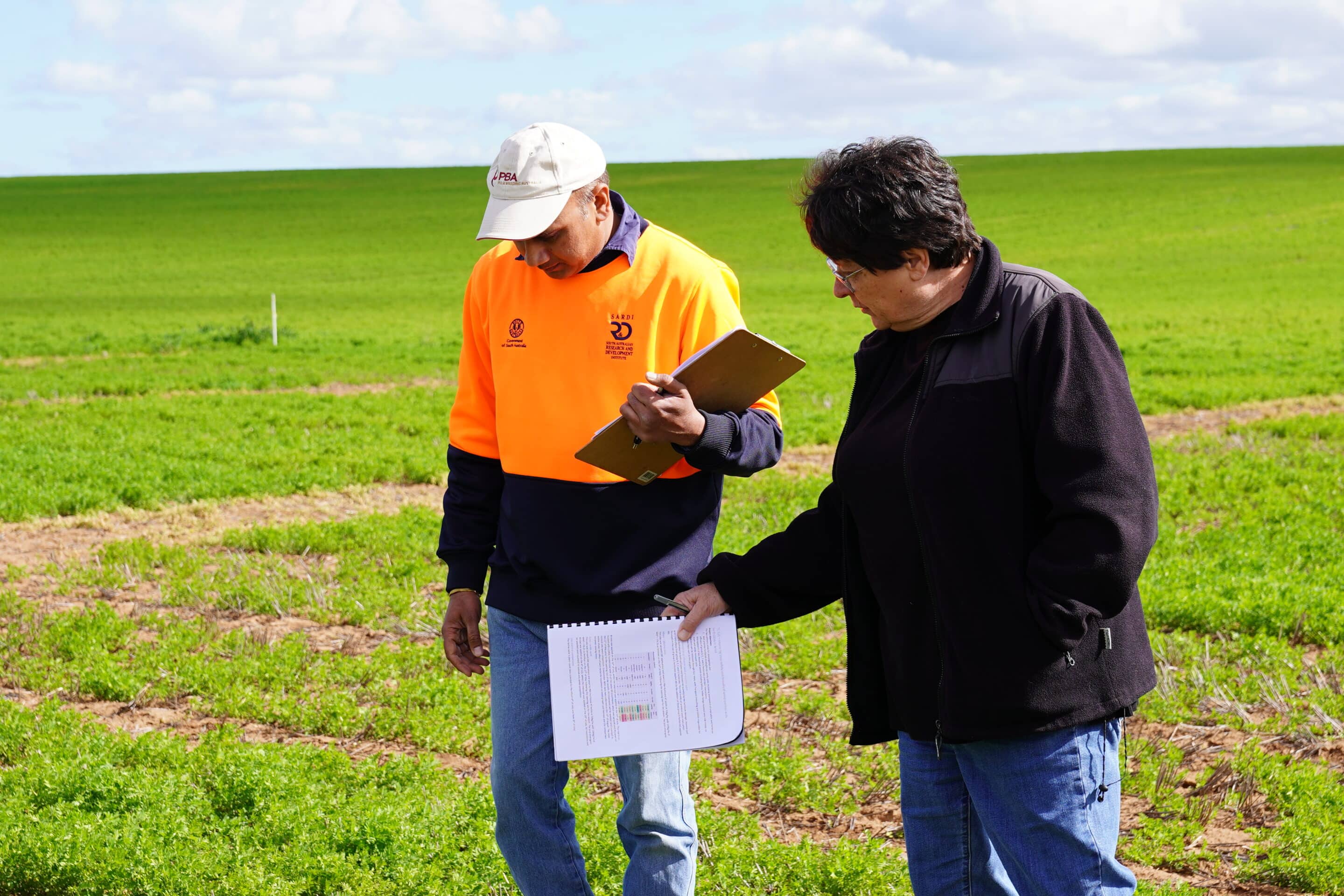START
FINISH

Summary
This project investigated new Group 14 herbicides for broadleaf weed control in lentils, to preserve the valuable Group 2 Imidazolinone herbicides.
In general, alkaline sands experienced the greatest crop effect and yield loss from Group 14 herbicide applications, with losses higher from Reflex® than Terrain®. Weed control was effective when a Group 14 was mixed with a Group 5 or followed by a Group 2 or 5 herbicide on bifora, common sowthistle, Indian hedge mustard, and marshmallow. When used alone, Reflex® showed greater control of some weeds, with other weeds similar across the Group 14 herbicides.
Herbicide strategies on high-risk alkaline sandy soil types need careful balancing to avoid crop damage and achieve adequate weed control.
Background
SAGIT project TC116, which ran from 2016 to 2019, investigated yield constraints in lentils in sandy soils on the Yorke Peninsula and identified that crop damage from herbicide combinations are one cause of low lentil yields. Project TC119 in 2019-2021 explored these herbicide effects in greater detail, identifying yield losses in high pH soils from Group 2 and 5 herbicides incorporated before seeding.
The availability of imidazolinone (Group 2) tolerant lentils has led to a heavy reliance on Group 2, risking extensive herbicide resistance. New modes of action for lentil weed control have recently become available including Reflex® (fomesafen 240g/L) and Terrain® (flumioxazin 500g/kg), which are both Group 14.
Research Aims
The two areas for investigation were:
- Best practice herbicide strategies on loam and sandy soils; including assessment of crop safety and herbicide efficacy of Group 2, 5, 12 and 14 herbicides alone and in combination.
- Management of key broadleaf weeds including bifora (Bifora testiculata), Indian hedge mustard (Sisymbrium orientale) and common sow thistle (Sonchus oleraceus), on loam and sandy textured soils.
In The Field
Experiments were set up at Bute, Paskeville, Wards Hill and Alford, with a total of eight trials over two seasons. Two acidic sand sites, two neutral-alkaline medium textured sites, and four alkaline sites were selected.
Small plots were sown using a knifepoint press wheel system, with herbicides applied using a 2m hand-boom. In-crop measurements included normalized difference vegetation index (NDVI), weed density, weed seed set and herbicide damage scores collected at multiple times assessing chlorosis, necrosis and stunting. All plots were harvested to record grain yields.
Results
Soil type had a large influence on lentil crop safety with alkaline sands experiencing more herbicide damage than acidic sands or medium textured soils.
Yield: Reflex® at 1L/ha resulted in a 21 per cent yield loss on alkaline sands averaged across 4 sites, with no loss from the same treatment on acidic sands. Yield losses increased when applied in combination with Group 5 herbicides on alkaline sands. Terrain® averaged only 5 per cent yield loss in alkaline sands, and 3 per cent in acid sands, despite significant plant loss. Yield loss was dependent on the season, with better crop recovery and less yield loss in the wetter 2022 season.
Efficacy: Reflex® or Terrain® applied in combination with registered Group 2, 5 and 12 herbicides provided effective control of bifora, common sowthistle, Indian hedge mustard, and marshmallow. Imidazolinone herbicide Intercept® did not provide effective control of Indian hedge mustard, indicating a developing resistance to IMI herbicides in this weed. Reflex® alone provided more effective control of bifora and capeweed than Terrain® or Intercept® (Group 2), though in marshmallow both Group 14 herbicides and Intercept® performed similarly.
Project Participants
Trengove Consulting: Sam Trengove, Stuart Sherriff, Jordan Bruce
SARDI: Navneet Aggarwal
The Problem
Problematic broadleaf weeds can be difficult to control in lentil and the availability of imidazolinone (Group 2) tolerant lentils has led to heavy reliance on Group 2, risking extensive herbicide resistance.
The research
This project studied new Group 14 herbicides on lentils for crop safety and weed control efficacy in a range of soils on the Yorke Peninsula.
More information
Sam Trengove,
Trengove Consulting Trust
T: 0428 262 057
E: [email protected]
Value for Growers
This project has demonstrated the efficacy of new Group 14 herbicides in controlling bifora, common sowthistle, Indian hedge mustard, and marshmallow, particularly in combination with Group 2 and Group 5 herbicides. Caution is required though as these herbicide combinations risk heightening crop damage, particularly on alkaline sandy soil types. Rotating imidazolinone herbicides with these herbicides will reduce selection pressure against imidazolinone and sustain its efficacy on important weeds into the future.
When using newer Group 14 herbicides in lentils, growers should select herbicides considering:
- Soil type – alkaline sands showed the greatest yield loss, with higher loss in Reflex® than Terrain, while in acid sands Reflex showed no yield loss at all.
- Seasonal outlooks – with low spring rainfall associated with higher risk of losses in Reflex® in alkaline sands.
- Weed species of concern – bifora and capeweed had higher control from Reflex® than Terrain®, while Indian hedge mustard and marshmallow showed similar efficacy between the Group 14 herbicides.
The outcomes of the project were communicated at 10 events over the two years including GRDC Updates at Adelaide and Bute.
Latest Research Projects













